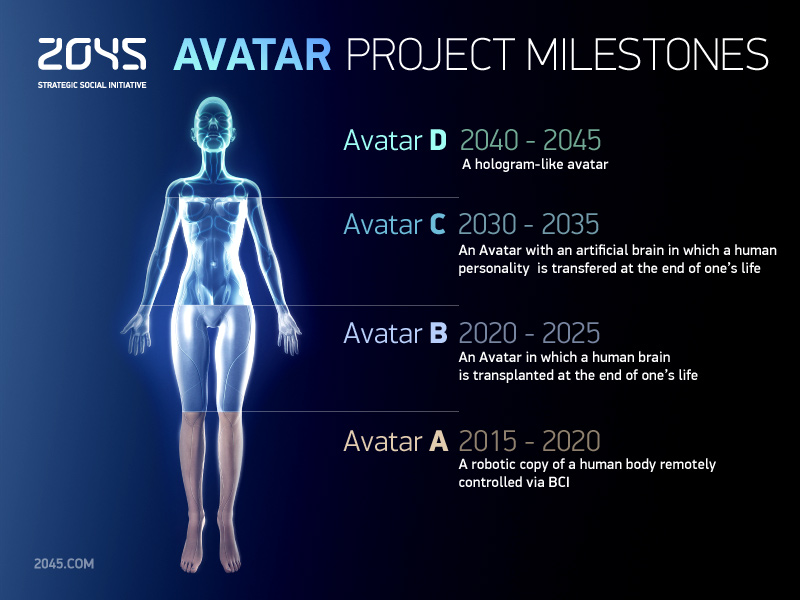
Robohub.org
Dreaming of Robot Avatars

I attended the conference, “Global Futures 2045″ at Alice Tully Hall in NYC on Saturday June 15th. I confess that I was a little skeptical about a conference about immortality and I voiced my skepticism to my colleague. The theme of immortality seemed somewhat egotistical and added to the stereo-typical characterization of the founder, multi-billionaire Dmitry Iskov. The conference was not without its glitches, which would have added to my skepticism were it not for the collective optimism and descriptions of scientific work that is being done by a wide range of presenters at the conference. I did leave with a better impression of the purpose for the conference even if it did drag on and was delayed for what now appears to have been a stalling tactic to allow for the (successful) unveiling of the Itskov Head, which sadly, never occurred. Still, the conference did have some significance for robotics. The conference started with a sincere address by Dmity Itskov who told the crowd that, regardless of the final outcome of trying to reach immortality by 2045, we must be aware of the realities of the condition of humanity and strive to improve life for all of humanity. Itskov’s Avatar project lays out a timeline for each of four stages to achieve an avatar that can accept the human mind. If you do not have dreams and try to reach for the stars, you are planning for a dull future and more importantly, you are not planning for the inevitable problems that will become unmanageable by not planning.
What did the conference have to do with the progress of present day robotics? We still need to dream to create new robots. Having a vision of the stages that robotic avatars need to take to eventually become hologram vessels for human essence seems like science fiction but it is a dream based upon scientific progress in many diverse fields including neuroscience, materials, quantum physics and computer science. While the eventual goal for the Avatar Project may be immortality, the plan for incremental success in that direction is a roadmap to future development and we have already made some progress toward that goal. In the “Roadmap to the Avatar Project” – each stage of development is described by the subject controlling the avatar/robot, the object of control or the vessel for the avatar and finally, what is the means of control, direct brain-machine interface through implants or something more complex like actually mapping the brain and interpreting the signals to control an avatar. There has been progress using direct brain implants, such as cochlear implant and control of external devices by quadriplegic individuals have shown progress and we can assume that by 2045 but these invasive implants are giving way to Neural Dust motes that can be injected into the brain and can function without the problems that the external interface creates. Still, it is just a step towards brain mapping where external signals could be deciphered electrically without implants and could be used to control external mechanisms
Some highlights of the talks I attended:
James Martin painted a bleak picture of the future quoting statistics of inevitable demise of the human race based solely upon the changes to the planet brought about by human intervention in natural and social structures – climate change, wars, depletion of natural resources that we will reach a tipping point from which we will not be able to recover, and that not counting some natural or cosmic intervention which we seem to be unable to predict.
Peter Diamodis has the key to survival on the planet – every problem creates new solutions and the opportunity to create something new. Founder of the X-Prize, Diamondis spoke of the Star-Trek-like “Tricorder” (link) that will enable lay persons to diagnose illnesses better that the best doctors on the planet. Creation of this kind of technology helps fuel advances in other practical areas like robotics.
The talk given by Jose Carmena and Michel Maharbiz was about the advances in implanted devices used to read the brain and enable users to gain access to physical functions have already made progress. The cochlear implant and control of external devices by people who are quadriplegic have shown progress and one can assume that by 2045 we may have realized Avatar #3
Hiroshi Ishiguro had his world famous Geminoid robot, his near-exact copy and his newer minimal telenoid, described in this article from IEEE Spectrum which he admitted may be the better robot. Without referring specifically to the uncanny valley, he conceded that it is better to leave something to the imagination so that people can project something to the robot
The intelligent robotic arm worn by Nigel Ackland in the “Avatar A” stage of the Avatar Project and although it is controlled by muscle impulses received in the arm and does not use direct a brain-machine interface, it is non-invasive and practical. Nigel said he has already receive several upgrades to his arm and that was accomplished by merely exchanging devices. The goal is to provide a direct replacement for the original human counterpart that the user can control seamlessly and without planning or thought. “Avatar B” would presumably be an arm that was grown from human tissue, controlled by direct brain-mapped electrical signals.
We were led to believe that the conference would be covered in such great detail that there would be no need for individuals to film the events or record the talks. That has proven to be less that advertised but I did come away from Global Futures 2045
with a sense of optimism and a belief that there are forces for good at work here on planet earth. Just my thoughts on the conference.




